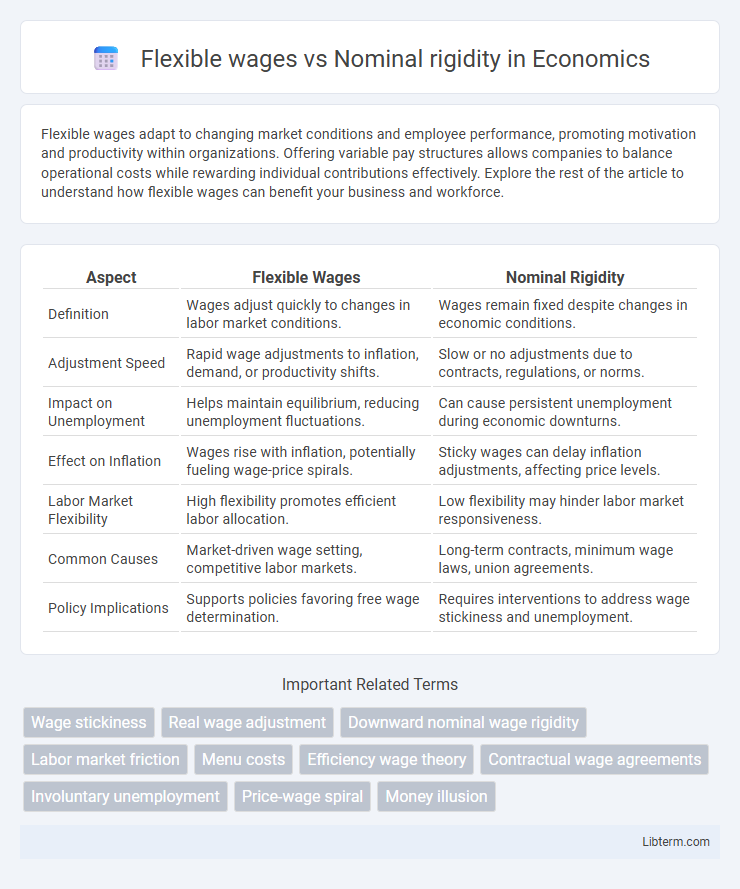Flexible wages adapt to changing market conditions and employee performance, promoting motivation and productivity within organizations. Offering variable pay structures allows companies to balance operational costs while rewarding individual contributions effectively. Explore the rest of the article to understand how flexible wages can benefit your business and workforce.
Table of Comparison
| Aspect | Flexible Wages | Nominal Rigidity |
|---|---|---|
| Definition | Wages adjust quickly to changes in labor market conditions. | Wages remain fixed despite changes in economic conditions. |
| Adjustment Speed | Rapid wage adjustments to inflation, demand, or productivity shifts. | Slow or no adjustments due to contracts, regulations, or norms. |
| Impact on Unemployment | Helps maintain equilibrium, reducing unemployment fluctuations. | Can cause persistent unemployment during economic downturns. |
| Effect on Inflation | Wages rise with inflation, potentially fueling wage-price spirals. | Sticky wages can delay inflation adjustments, affecting price levels. |
| Labor Market Flexibility | High flexibility promotes efficient labor allocation. | Low flexibility may hinder labor market responsiveness. |
| Common Causes | Market-driven wage setting, competitive labor markets. | Long-term contracts, minimum wage laws, union agreements. |
| Policy Implications | Supports policies favoring free wage determination. | Requires interventions to address wage stickiness and unemployment. |
Understanding Flexible Wages and Nominal Rigidity
Flexible wages adjust quickly in response to labor market conditions, allowing employers and employees to negotiate pay based on current economic variables such as inflation or productivity changes. Nominal rigidity occurs when wages are slow to adjust downward despite negative shifts in demand or economic downturns, often due to contracts, social norms, or regulatory constraints. Understanding the contrast highlights how flexible wages facilitate equilibrium in the labor market, while nominal rigidity can contribute to unemployment and wage stickiness during recessions.
Theoretical Foundations of Wage Flexibility
Theoretical foundations of wage flexibility emphasize the ability of wages to adjust in response to labor market conditions, inflation, and productivity changes, allowing for efficient allocation of resources. In contrast, nominal rigidity refers to wage stickiness caused by factors such as long-term contracts, labor union agreements, and institutional regulations that prevent wages from adjusting in real-time. Models like efficiency wage theory, insider-outsider theory, and staggered wage-setting frameworks illustrate mechanisms underpinning nominal rigidity and the economic consequences of limited wage flexibility.
Origins and Causes of Nominal Wage Rigidity
Nominal wage rigidity originates from factors such as long-term labor contracts, efficiency wage theories, and worker morale concerns, which prevent wages from adjusting quickly to market fluctuations. Institutions like minimum wage laws, collective bargaining agreements, and labor market regulations contribute significantly to the persistence of nominal rigidities. Economic uncertainty and asymmetric information between employers and employees further reinforce wage stickiness despite changes in demand or productivity.
Macroeconomic Implications of Wage Flexibility
Flexible wages allow labor markets to adjust swiftly to economic shocks, reducing unemployment fluctuations and enhancing overall macroeconomic stability. Nominal rigidity in wages, characterized by slow adjustments due to contracts or norms, can exacerbate unemployment and prolong economic downturns by hindering the labor market's response to changes in demand. Macroeconomic models emphasize that increased wage flexibility improves labor market efficiency, accelerates recovery from recessions, and supports stable inflation dynamics.
Nominal Rigidity and Unemployment Dynamics
Nominal rigidity refers to the resistance of wages and prices to adjust immediately to changes in economic conditions, leading to a mismatch between labor supply and demand. This rigidity causes unemployment dynamics to persist, as firms are unable to reduce wages during downturns, resulting in excess labor supply. Consequently, the slow adjustment process prolongs unemployment spells and slows economic recovery.
Flexible Wages in Labor Market Adjustments
Flexible wages enable labor markets to adjust efficiently to economic fluctuations by allowing wages to rise or fall based on supply and demand dynamics. This wage elasticity reduces unemployment risks by facilitating quicker equilibrium between labor supply and demand. Empirical studies highlight that economies with more flexible wage structures exhibit faster recovery rates from recessions and lower structural unemployment levels.
Real-World Evidence: Flexible Wages vs Nominal Rigidity
Real-world evidence highlights that flexible wages allow labor markets to adjust more efficiently to economic shocks, reducing unemployment and enhancing productivity. In contrast, nominal rigidity, where wages remain sticky, often leads to prolonged unemployment and slower recovery during recessions due to inflexible labor costs and adjustment delays. Empirical studies across various economies consistently demonstrate that labor markets with greater wage flexibility exhibit stronger resilience and quicker responses to demand fluctuations.
Policy Approaches Addressing Wage Rigidity
Policy approaches addressing wage rigidity often involve promoting flexible wage-setting mechanisms to enhance labor market adaptability and reduce unemployment. Implementing performance-based pay, decentralizing collective bargaining, and encouraging wage indexation to productivity can help mitigate nominal rigidity. Targeted labor market reforms aimed at reducing institutional constraints, such as minimum wage adjustments and easing firing costs, further support wage flexibility and economic resilience.
Comparative International Perspectives on Wage Flexibility
Countries with flexible wage systems often experience quicker economic adjustments and lower unemployment rates compared to those with nominal wage rigidity, which tends to sustain labor market inefficiencies. Scandinavian economies, known for flexible wage bargaining, demonstrate higher labor market responsiveness during economic fluctuations than Southern European nations where nominal rigidity prevails. Empirical studies indicate that wage flexibility enhances competitiveness and labor mobility, while nominal rigidity contributes to prolonged unemployment and slower recovery from economic shocks.
Future Trends: Evolving Wage Structures in Modern Economies
Flexible wages adapt dynamically to market conditions, enabling labor markets to respond efficiently to economic fluctuations, while nominal rigidity causes wages to remain sticky despite changes in demand and inflation. Future trends indicate a shift towards hybrid wage structures incorporating performance-based incentives, digital platforms for wage adjustments, and real-time data analytics to balance flexibility with worker stability. Emerging economies are increasingly adopting algorithmic wage-setting tools to reduce nominal rigidities and enhance competitiveness in a rapidly evolving global labor market.
Flexible wages Infographic

 libterm.com
libterm.com